Great Lakes Salmon Fishing: River Fishing Tactics Of Guides
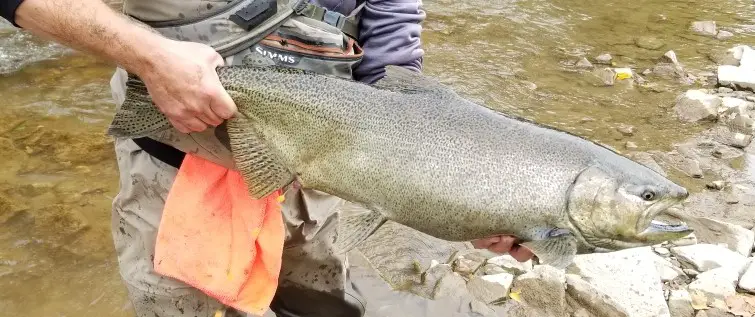
Anglers around the Great Lakes have a unique opportunity for some excellent river fishing for huge salmon that enter the rivers by the tens of thousands between August and November.
The most effective methods for catching Great Lakes salmon include float fishing, fly fishing, lure fishing, drift fishing, and bottom bouncing. Other methods like back trolling and back bouncing can also be very effective on larger rivers.
I have been fishing for salmon since I was a teenager and I have been guiding for them for 20 years. I will include the most effective tactics and baits that I use when I guide and when I teach anglers how to fish for salmon in the rivers.
My Best Guide Tips For Great Lakes Salmon In Rivers
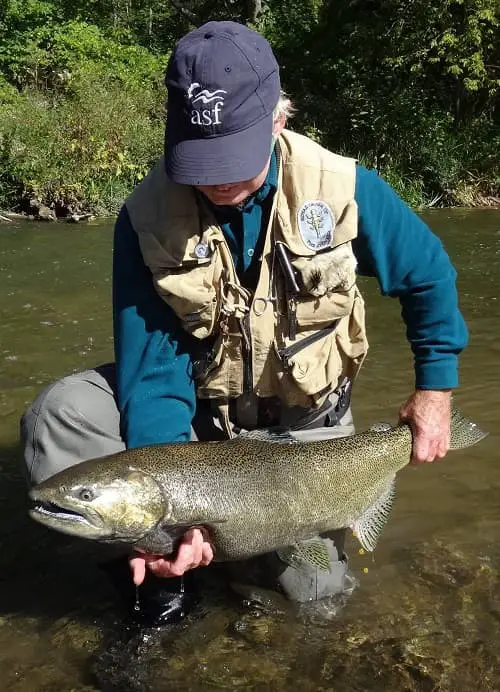
GUIDE TIP: If you are going to fish for salmon, I highly recommend that you put a little extra effort into learning how to do it right and do a little extra planning ahead of time so that you have everything you actually need to succeed.
The simple truth of the matter is that most anglers get one or two things wrong when they fish for salmon in rivers, which prevents them from catching fish.
It is easy to catch salmon if you do it all correctly. Ensure you follow the simple tips that I provide to my clients.
- Right Gear: Have the right gear for salmon fishing, which includes the rod, reel, mainline, and even wader and boots.
- Use The Right Line: Salmon are huge and fight hard. Be sure you have the right type of line and the right size of the line, which is usually a ten or twelve-pound line for most rivers.
- Right Leader: Your leader should be fluorocarbon and should be the same size or one size smaller than your mainline, which means 10 to 12 pounds.
- Leader Setup: Too many guys set up their leaders wrong. Use the same proven leader setups as guides and you will catch more salmon. I will show you below.
- The Right Hooks: Use the right hooks for the size and type of bait that you are using.
- Master Presentation: If you can get a great presentation you will catch fish, if you don’t you will catch few if any fish. It’s not hard, pay attention.
- Cover The Water Well: Covering the water well means covering all areas that might potentially hold salmon and covering the right depths so your bait or lure is in the strike zone.
- Choose Your Bait Wisely: Choose your bait based on the conditions and when the salmon want. I see guys using so many different baits, but I’ve tested most baits, and only a few work consistently well.
- Know When The Runs Happen: Know when the salmon run, and what triggers those runs so you know when to fish the peak times.
This article will help you get everything right.
Salmon Species Of The Great Lakes
There are four species of salmon that anglers around the Great Lakes can fish for. Some of these salmon can be found in large numbers and are still stocked regularly, while other salmon species have low numbers.
Great Lakes Chinook Salmon
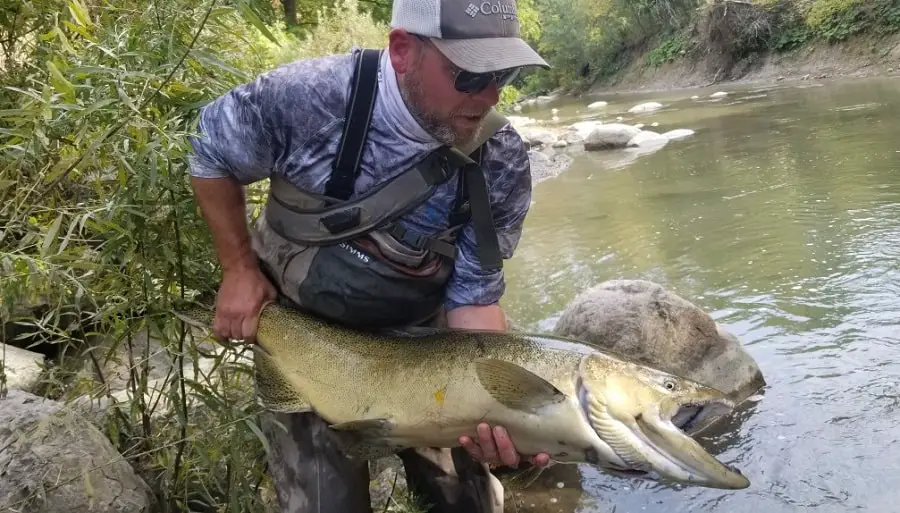
Chinook salmon are the most common salmon around the Great Lakes and can often be found in large numbers with average sizes around twenty to twenty pounds, with some reaching sizes over 40 pounds.
Because of their size and numbers, they are the most sought-after salmon species.
Chinook salmon can be found in large numbers in Lake Ontario, Lake Michigan, and Lake Huron but they are also found in Lake Superior and in lesser numbers in Lake Erie.
Great Lakes Coho Salmon
Most of the Great Lakes have Coho salmon. Coho are smaller in size than Chinook salmon, averaging 7 to 12 pounds, up to 25 pounds.
The world record Coho is from the salmon river in New York.
The runs of coho salmon are also much smaller than the chinook salmon. Coho’s can run from early September to late November.
Coho salmon are sought by anglers fishing Lake Ontario, where their numbers are the largest. They tend to come up in good numbers and jump a lot when hooked.
Some coho salmon can be found in Lake Huron and Lake Michigan in decent numbers, but Lake Erie and Lake Superior have very low numbers of Coho Salmon.
Atlantic Salmon Of The Great Lakes
There has been a push to reintroduce Atlantic salmon to Lake Ontario and Lake Huron, but only some rivers are seeing good returns of adult Atlantic salmon.
The best success with stocking and the best numbers of returning adult Atlantic salmon is to the St Mary’s River. Other rivers of Lake Huron and Georgian Bay do not have any significant runs of Atlantic salmon, and the rivers of Lake Ontario have very low returns.
If you want to fish for the Atlantic salmon of Lake Ontario, you should consider the Salmon River in upstate NY or the Ganaraska River in Ontario, Canada.
Atlantic salmon are known to reach sizes over 50 pounds, but so far, Atlantic salmon over 30 pounds are rare on the Great Lakes.
Pink Salmon Of The Great Lakes
Pink salmon is a rare species that only run on odd-numbered years like the years of 2025, 2027, 2029, etc.
Although there is some natural reproducing Pink Salmon, their numbers are low in most rivers.
Know Where To Fish For Great Lakes Salmon In Rivers
I have fished for salmon and steelhead from New York state to Michigan and in Ontario Canada.
All the rivers around the Great Lakes have the potential for some salmon runs, but there are some rivers, creeks, and areas that will have more salmon, and they will fish better than others.
Salmon Fishing By State
For the best rivers, tips, best guides, and advice on fishing salmon around the great lakes in specific areas, check out these pages:
- Fishing Salmon In New York State
- Fishing Salmon In Michigan
- Fishing Salmon in Wisconsin
- Fishing Salmon In Minnesota
- Fishing Salmon In Pennsylvania
- Fishing Salmon In Ohio
- Fishing Salmon In Ontario
Gear For Salmon Fishing Great Lakes Rivers
The first step to catching more salmon on Great Lakes rivers is to use the right gear.
Using a 7’6 to 9-foot rod to float fish for salmon, or to bottom bounce, or even to throw lures is common.
When fishing for salmon, longer and stronger rods are the key, and I use different sized rods for different methods. See Best rods for salmon.
Choose larger reels, in the size 3500 to 4500 with a good smooth drag system.
Salmon anglers can use spinning reels that are suitable for big salmon. Baitcasting reels are also a good option, and if you want to float fish you can’t beat the Centerpin reels.
Even using the wrong float when float fishing will prevent you from catching fish so make sure you use floats that are meant for float fishing, and I will discuss this more below.
A simple thing like having a good river net for salmon is also important and will help you land the next giant salmon.
I discuss the best gear that good anglers use for each method below, but for all the general-purpose river fishing gear like waders, boots, vests, packs, and even the best release tools, check out my page on Best River Fishing Gear.
Use The Right Methods For More Salmon
There are four effective methods for catching Great Lakes salmon in rivers.
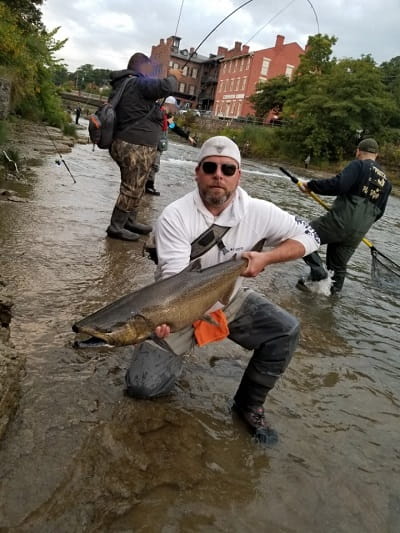
Float Fishing For Great Lakes Salmon
Float fishing is often the most popular and the most effective way to catch salmon in medium to large rivers.
Float fishing allows anglers to present a bait under a float in a controlled manner. Float fishing is the best method for both active and neutral active salmon.
Float fishing effectively requires the use of the right rods and reels, lines that work for float fishing, proper floats, a great leader setup, and the right baits. I cover all of these things in greater detail on my page, Float Fishing For Salmon.
Fly Fishing For Great Lakes Salmon
In rivers that are 1 foot to 6 feet, deep fly fishing using an indicator or streamer can be a very effective method. When salmon are in faster, shallower water of 1 to 3 feet deep, I think fly fishing using my advanced nymphing techniques is the best method for catching salmon.
Nymph fishing for salmon is the method that I use the most becuase in my opinion it is the most effective method for salmon in water from 1 foot up to 10 feet deep.
Streamer fishing for salmon is also productive at times. Streamer fishing is a great way to get large aggressive salmon to smash your fly hard, which makes for a very exciting experience.
Another method that is growing in popularity is Spey fishing and swinging flies for salmon. This is a similar method to streamer fishing without the erratic retrieve that you would use with streamer fishing.
I discuss all of these methods in great detail as well as my favorite salmon flies on my page, Fly Fishing For Salmon.
Bottom Bouncing For Great Lakes Salmon
Bottom bouncing is a method that was popular in the 70’s and 80’s but was quickly overshadowed by float fishing.
When the salmon are in shallower water, fast water, or in pocket water, this is when bottom bouncing is the best method for catching them.
To learn how to bottom bounce at Bottom Bouncing.
Lure Fishing For Great Lakes Salmon
Lure fishing for salmon is another method that anglers love to do because it can be very productive and very exciting. The thrill of having a huge salmon smash a lure hard and then run and pull out a hundred feet of line is hard to beat.
I recommend using a longer beefy rod of 8 to 9 feet with stronger lines of 12 to 14 pounds and with a spinning reel or baitcasting reel that can hold lots of line, and one that has a great drag system.
I like to use bright-colored lures that have a lot of action when they are reeled in slowly. Lures like spinners, spoons, Kwickfish and crankbaits like the Storm Tunderstick are good salmon lures.
I discuss my favorite lures and my most effective tactics for catching salmon with lures on my page Lure Fishing For Salmon: Guide Tactics For More Salmon.
Twitching jigs is another method that can be very effective.
See Twitching Jigs For Salmon.
Best Baits For Great Lakes Salmon Fishing
There are a lot of different baits that I use when fishing for Great Lakes salmon. Eggs sacs, skien, beads, and pink worms top the list. I discuss these and more baits on my page the Best Baits For Salmon Fishing.
When Do Great Lakes Salmon Run?
You may have got to the river and heard guys saying “You should have been here three days ago” or “They ran last week”.
Knowing when the salmon will run is a guide trick that allows me to get my clients into a lot more fish, and it can really help you catch a lot more salmon. I watch the weather and the river flow charts to help me know when the runs should start.
The first thing you need to know is that the salmon runs on most Great Lakes rivers will occur in late August and will peak later in September and early October. What triggers the salmon runs are rain, water temperatures, and even winds.
Atlantic salmon are also known to enter some rivers in June and July but will continue to enter some rivers in October.
Rains Trigger Salmon Runs
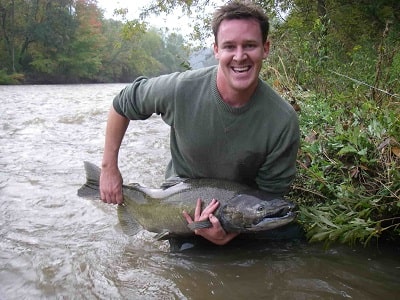
In very shallow rivers, it will often take a big rain to raise the water levels up enough to get them to run up the river.
This is the easiest way to predict the salmon runs.
What happens is the salmon will stage offshore, which means they will start moving in closer to shore looking for their preferred river, and this usually happens in August.
When the rivers are very low, the river that enters the lake is slower and doesn’t go very far out into the lake. As the river waters rise, the current will flow further out onto the lake, and the further it flows the more salmon will swim through that current and trigger a run. A river that only flows a few hundred yards will only attract so many fish, but a strong current that flows a mile out into the lake will attract a lot more fish.
If that current is cold enough, it will trigger more fish. If the water is too warm, the salmon may not want to swim through it. That is why bigger rains later in September, when the nights are colder, will bring up a lot more fish. Smart anglers and guides will make sure they are on the river that day or the next day. (1)
Combined with the urge to spawn higher water, it will bring in even more fish even if the water temps are not ideal.
I also watch the flow charts for the rivers to see how much the water actually went up. If the water goes up a lot, that could mean a big run, but it can also mean the river might go muddy and that will make it tough fishing.
Temperatures Trigger Runs Of Salmon
On larger rivers that already have good higher flows out into the lake can often have runs of salmon that can come up at any time, however, the colder the nights get and the colder the river gets the more salmon will enter those rivers.
These larger rivers are harder to predict the runs and often small runs of fish could come in daily and for no reason, however, once the after cold nights and when water temps start to get into the low 60’s and high 50’s the salmon will run the rivers in larger numbers.
Winds Can Trigger Salmon Runs
I have seen the salmon run for no apparent reason. However, when you look closely at the conditions, sometimes that reason is simply just the direction and the strength of the wind.
Stronger winds coming offshore and out into the lake can push baitfish and the salmon further out, which might mean the salmon won’t be able to detect the rivers, but strong winds blowing into shore can push those salmon closer to shore, where they will find the flow of the river and that can trigger large runs of salmon.
Smart anglers in my area watch for these wind shifts and will hit the river that day and the next day with often good results.
Spawning Urges Trigger Salmon Runs
I have seen years when there are droughts, and the rivers are super low and too warm, but the salmon still need to run, so they do.
If the conditions are not suitable, the salmon will stage close to the rivers for as long as they can, and they will continue to school up in larger and larger numbers until the urge to spawn forces them to run up the rivers even in super low conditions. Once some start to go, others will follow.
Salmon Fishing Guides: Learn To Fish For Salmon
As a river guide, I know the value a river guide can provide. A good guide will know when the salmon run, which methods are best to use, they will know where to fish, and they will teach you the right way, which is a great lifetime investment.
Tight Lines
Graham

Is there salmon in the chagrin river?
Hi Jade,
There is Coho salmon caught in the Chagrin River in September and October. There are occasional reports of other salmon species caught in Lake Erie tributaries. Where these salmon are coming from is often debated but there is nothing stopping Coho, Chinook, Atlantic, and even pink salmon from migrating down from Lake Huron and into the Ohio rivers.
Graham
Hi Graham,
really first class information here. I live in Nr Ireland and have been to BC fishing with two friends however we really would like to fish some where on the Great Lakes system for King Salmon, but realise the importance of a good guide and information. We all three are very experienced Atlantic Salmon fishermen i my self have caught more than 1500 , float and fly fishing. We could travel at any time (retired)and would want to fish for five full days (float and fly) with a guide at all times ,could you please advise re times, guides ,area etc ,and perhaps you yourself would be available.
Many Thanks ,
Brian.
Hi Brian,
in my opinion, some of the best King salmon fishing around the great lakes, with the least crowds is in Western Michigan. There is some great king fishing in New York, Ontario Canada, and in Wisconsin too but those rivers can get very crowded.
I would check with Betts Guide Service, or with John at https://www.instagram.com/getbentguideservice_mi/ or with Alex at https://www.instagram.com/fireplug_charters/ .
Best of luck,
Graham